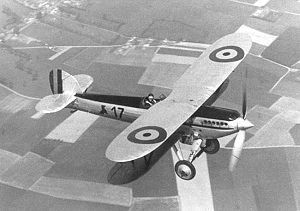Fairey Firefly IIM
| Firefly IIM | |
|---|---|

| |
| Belgian Fairey Firefly Y-17 from 3/II/2 Aé (Red Cocottes) Squadron near its home base at Nivelles. Fairey c/n F-1505 was delivered from Fairey Hayes (UK) on 21 August 1931. | |
| Role | Fighter |
| Manufacturer | Fairey Aviation Company Limited
|
| Designer | Marcel Lobelle |
| First flight | 5 February 1929 |
| Introduction | 1931 |
| Primary users | Belgium USSR |
| Number built | 91 |
The Fairey Firefly IIM was a British fighter of the 1930s. It was a single-seat, single-engine
Design and development
The Firefly was a private-venture design, penned by
The Firefly II competed for the
A revised prototype with longer-span wings, the Firefly III was built to
Operational history
A contract was won for 25 IIM aircraft for Belgium's
Two of the Belgian aircraft were converted to Firefly IV, with 785 hp (585 kW) Hispano-Suiza 12Xbrs engines but the improvement was not deemed sufficient to warrant development. One was restored to its original form, while the other passed to Fairey for trials. One aircraft was supplied to the Soviet Union.
Operators
- Belgian Air Force
- Soviet Air Force– One Firefly Mk IIM, used for tests and trials.
Variants
- Fairey Firefly II
- Single-seat fighter prototype, powered by a 480 hp (360 kW) Rolls-Royce Kestrel piston engine. One built.
- Fairey Firefly IIM
- Single-seat single-engine fighter aircraft, of all-metal construction, equipped with resigned tail surfaces and revised engine cooling system.
- Fairey Firefly III
- Single-seat shipboard fighter prototype. One built.
- Fairey Firefly IIIM
- The Fairey Firefly III was rebuilt with all-metal construction and redesignated Firefly IIIM.
- Fairey Firefly IV
- Two Belgian Firefly IIs were converted, and fitted with the 785 hp (585 kW) Hispano-Suiza 12Xbrs engine.
Specifications (Firefly IIM)
Data from The Complete Book of Fighters[5]
General characteristics
- Crew: 1
- Length: 24 ft 8 in (7.52 m)
- Wingspan: 31 ft 6 in (9.60 m)
- Height: 9 ft 4 in (2.84 m)
- Wing area: 236.8 sq ft (22.00 m2)
- Empty weight: 2,387 lb (1,083 kg) equipped
- Gross weight: 3,285 lb (1,490 kg)
- Max takeoff weight: 3,404 lb (1,544 kg) [6]
- Powerplant: 1 × Rolls-Royce F.XISV-12 liquid-cooled piston engine, 480 hp (360 kW)
- Propellers: 2-bladed fixed-pitch propeller
Performance
- Maximum speed: 175 mph (282 km/h, 152 kn) at sea level, 223 mph (194 kn; 359 km/h) at 13,125 ft (4,000 m)
- Range: 240 mi (390 km, 210 nmi) [4] (Firefly II)
- Service ceiling: 30,800 ft (9,400 m) [7]
- Time to altitude: 10 minutes 55 seconds to 20,000 ft (6,000 m)
Armament
- Guns: 2 × 0.303 in (7.7 mm) Vickers machine guns
See also
Related development
Aircraft of comparable role, configuration, and era
Related lists
References
Notes
Bibliography
- Garcia, Dionisio. "Air Force on the Edge: Belgian Military Aviation in 1940". ISSN 0143-5450.
- Green, William and Gordon Swanborough. The Complete Book of Fighters. New York: Smithmark, 1994. ISBN 0-8317-3939-8.
- Mason, Francis K. The British Fighter since 1912. Annapolis, Maryland: Naval Institute Press, 1992. ISBN 1-55750-082-7
- Pacco, John. "Fairey Firefly" Belgisch Leger/Armee Belge: Het militair Vliegwezen/l'Aeronautique militaire 1930–1940. Artselaar, Belgium, 2003, pp. 32–38. ISBN 90-801136-6-2.
- Taylor, H. A. Fairey Aircraft since 1915. London: Putnam, 1988. ISBN 0-370-00065-X.
- Taylor, John W. R. and Jean Alexander. Combat Aircraft of the World. New York: G.P. Putnam's Sons, 1969. ISBN 0-71810-564-8.
- Willis, Matthew. "Database: Fairey Firefly". ISSN 0143-7240.
External links
- Fairey Firefly II (Biplane) – British Aircraft of World War II
